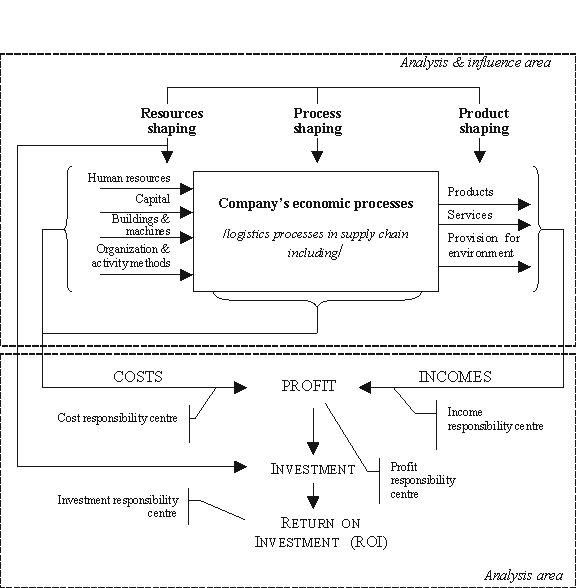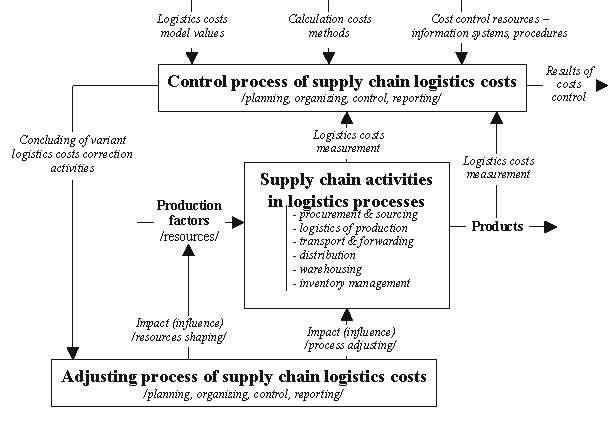|
|
|
SUPPLY CHAIN MANAGEMENT INSIDE COMPANY VALUE SYSTEM Bogusław Śliwczyński ABSTRACT The comprehension of business processes interactions along supply chain is an important factor to succeed in the fast changing and competitive business arena. From competitive point of view there are some critical issues for companies in every day activity: the pressure to reduce overall supply chain costs, exploiting company's assets more effectively, more effective cooperation with trading partners and improving service level of customer. Those issues are the main goal of supply chain's control at first step and managing value of product in supply chain at second step. The ability to create and increase product value in supply chain depends on the ability to control it. Today, each activity (or participant) in the supply chain is analyzed according to its value it adds to process. As a result, this analysis facilitates removing wasteful activities by applying trade-off analysis and what-if scenario modeling analysis of alternatives. Costing methods provide information about costs allocation and how profitable each customer is to a supplier, and the supplier to the customer. Applying this approach to cost measurement of the value chain also enables companies better to understand the cost of their customers, suppliers, products and processes as they move through the complex supply chain both internally and externally to the company. Analysis of supply chain value starts from the activities of ordering, gathering and processing of raw materials, through material management at production phase, until distribution and delivery to the target customer. One crucial condition of the value analysis in supply chain is to obtain financial transparency in order to optimize decision-making concerning the level of engaged resources and their allocation or activity performance. Today suppliers need to meet the challenge how to measure the activity costs, processes and product movements - from sourcing and procurement and manufacturing to though storing, freight distribution and delivery. Value chain analysis (VCA) provides companies with insights into their own cost behaviour. The value chain analysis is used by a company to examine objectively costs attributed to products moving along its value chain (including insights to impact of external supply chain costs). Value Supply Chain Analysis (VSCA) is the method designed to monitor the costs of products in time as they move through the supply chain. In this meaning product is a result of an activity (or group of activities) that has a particular value for a receiver (customer). The term of value stream in supply chain is defined as all the steps - both value added and non-value added - required to bring a product from the raw material to the customer. In every day activities of a company there is a number of key issues that became most significant regarding competitive position of company and its product on the market, such as:
Those issues are the biggest concern of at first supply chain's controlling and then while managing its value of product. Area of analysis and influence of operational controlling on company's activity in a supply chain is presented in figure 1.
The ability to create and increase product value in supply chain depends on the ability to control it. One way is to better understand how each internal/external activity (e.g. in cooperation with a trading partner) or resources allocation affects the extended chain's cost structure. Reliable measures can foster better communication, analysis and understanding of how the various diverse processes and functions within company such as procurement, shipping and warehousing can collectively reduce costs. The idea of designing lean material flow in supply chain as a main point of mapping activity and resources allocation is represented by the future state map that aims at creating a vision of how the value stream should operate from raw material down to the finished product (in "door-to-door" process). To manage supply chain inside company's integrated value chain Activity-Base Management (ABM) method as costing methodology is increasingly accepted. ABM is used to calculate costs of diverse outputs - including products and customers - and what is the cause of these costs. ABM method shows an organization that focuses on profit margins and unit-cost comparisons, in order better to understand what generates the costs in supply chain. Cost analysis in supply chain bases on measures, traces and expenses spent to calculate costs including product-making costs as well as the customer-related costs or costs-to-serve that are involved with front-office customer handling and service. The control and adjusting loop-back of supply chain logistics costs, make up an important part of real system of value chain management in a company. Such costs feedback focused on supply chain activities in logistics processes, supply chain resources and products is presented in figure 2.
The identification of differences in costs bearing and profitability of supplying various customers with various products using various logistics services is the fundamental task of value calculation. Value management in supply chain needs to reflect various customer demands and different logistics activities in costs calculation. Separating different distribution supply chains (with different products to different segments of market and groups of customers) lets to treat it as a profit center and makes it possible to match proper ways of management. Example of multidimensional costs analytical sheet according to variable costs algorithm for company's supply chains is presented in table 1.
On the basis of calculation results it is possible to determine sale profitability and to study relationships between production/sale changes and income/cost/profit changes. Related to above costs analytical sheet, ABM method gives a broad snapshot of costs that help to determine what to focus on and where. On the other hand, the VSCA method is already focused on testing the costs and benefits of changes. Commonly used applications that involve mentioned methods include:
Effective management system of supply chain value should calculate and report the consequences and impacts of decisions and changes. These cost changes should range from "what-if" scenarios of alternative business actions to gap analysis between "as-is" and "to-be" business process reengineering. Activity-Base Management supports profit and value control that is essential for operations control in supply chain. Operations control methods applied in supply chain and related to Balanced ScoreCard support both: management of customer and product perspectives (that determine sale incomes) as well as process and resources perspectives (that determine supply chain costs). Relationships between those perspectives using ABM method context applied in a distribution chain are presented in figure 2. Identification and decision making process that is supported by ABM method is considered in the figure in the context of benefits and advantages across the supply chain. ABM method that is crucial for the value in supply chain analysis bases on Activity-Base Costing (ABC).
Managing supply chain inside company value system requires reliable data from the company information system. Business partners cooperation in changing environment requires mass data flow acquisition and quasi-real time processing in many areas of supply chain, e.g. sourcing, warehousing, inventory control, production planning and materials handling, distribution and selling, finance management, etc. All mentioned methods and tools aim at processes rationalization together with suppliers (sellers) and receivers (buyers) that increase competitiveness in whole supply chain and complex supply network. Cost measures in the supply chain make mutually acceptable base, which allow for adjustments in supply chain. Without this agreed base, no change can occur. The supply chain value analysis uses industry-standard language to foster communication across internal departments and external trading partners. It has a library of predefined activities (e.g. receive, store, pick, move), product handling units (e.g. pallets, roll cages, cases), costs drivers (e.g. products, vehicles, routes to market, in-store fixtures, etc.) and other terms. In the process of planning and verification of optimal activities in logistics processes, it is very useful to apply SCOR business process reference model. The model links process elements, measures, best practices and the features associated with the execution of a supply chain in a unique format. The model focuses on the activities involved, not the person or organizational element that performs the activity. One of the most important aspects in creating value across supply chain is to associate cycle time measures of reliability, responsiveness and flexibility (in external chain - customer oriented) with area of costs and assets (in internal facing chain). Apart from the five basic management processes (Plan, Source, Make, Deliver and Return) that provide the organizational structure of the SCOR-model, it is useful to mention the three classical management activities in the model: planning, execution, and enabling (formerly infrastructure). It is essential to use the SCOR model as a tool in operations control when aiming to create value in supply chain. Planning of activities (or processes) that base on SCOR model allows better resources alignment and in consequence, to meet expected requirements. Planning processes balance aggregated demand across a consistent planning horizon and generally occur at regular intervals and can contribute to supply chain response time. It is important that, like the process elements themselves, the measures of those processes or their activities are hierarchical. It is very useful for the logistics strategy controlling based on value measures in supply chain to head for activity managing and resources (assets) allocation according to the guidelines of four perspectives of BSC. Effective execution of strategic plan and competitive position achievement needs mapping aims into operational activities. The success on the market is attainable by communicating strategic and operational goals on each level of company's organizational structure. The Balanced Scorecard Methodology (BSC) should also consider system and process connection of company in procurement as well as co-operation or distribution supply chain. Analytical data of a value chain provides company with insights into their total product cost and profit behaviour. Structural analysis focuses on desired achievements of value and productivity in supply chain based on the organization's broad aims and objectives. Managers are aware of inputs such as business strategy, management philosophy and organizational culture or all major determinants of organizational productivity (methods of cooperation, information exchange) which are not easy to quantify. It means that multi-dimensional value and productivity is difficult to analyze quantitatively. Hence that is the reason why so many management philosophies have been proposed: management by objectives (MBO), zero-based budgeting (ZBB), total quality management (TQM), business process reengineering (BPR), activity-based management (ABM), management by project (MBP), team-based management (TBM), etc. Unfortunately, there is no universally accepted model for internal and external supply chain productivity improvement, just guidelines, the success of which depends heavily on the nature of the organization and the approach of the individuals attempting to implement them. These guidelines listed below are used for conducting a productivity improvement in supply chain to achieve its higher value:
CONCLUSIONS Concluding these considerations about supply chain management inside company value system it is essential to point out VSCA method that delivers financial intelligence which a company can use to calculate the direct product cost (DPC). Value management in internal and external supply chain requires and includes:
VSCA method allows a company to look both inside and outside its operation in order to achieve maximum benefits from improvement initiatives. The paper presents methods and tools used to manage the value of supply chain that include controlling as a support system for management and integration of products, processes and assets in supply chain. REFERENCES Gadiesh O., Gilbert J. L., 2001, Transforming Corner-Office Strategy into Fronline Action, Harvard Business Review, 73-79. Kaplan R.S., Norton D. P., 2001, The Strategy Focused Organization. How Balanced Scorecard Companies Thrive in the New Business Environment. Boston-Massachusetts, Harward Business School Press. Rother M., Shook J., 1999, Learning to see - value stream mapping to create value and eliminate muda. The Lean Enterprise Institute, Brooklin Massachusetts. Śliwczyński B., 2005, Controlling operacyjny łańcucha dostaw brakującym ogniwem Strategicznej Karty Wyników, LogForum 2; 2; 2; URL: http://www.logforum.net/vol2/issue2/no2. ZARZĽDZANIE ŁAŃCUCHEM DOSTAW W SYSTEMIE WARTOŚCI PRZEDSIĘBIORSTWA
STRESZCZENIE Zdolność do interakcji procesów biznesowych przedsiębiorstw w łańcuchach dostaw jest ważnym czynnikiem sukcesu w szybko zmieniającym się otoczeniu konkurencyjnym. Dążenie do redukcji kosztów łańcuchowych produktu, efektywne wykorzystanie zasobów przedsiębiorstwa czy efektywna współpraca z partnerami biznesowymi w łańcuchu dostaw, stanowią wybrane przykłady wielu zabiegów zmierzających do podwyższenia pozycji konkurencyjnej przedsiębiorstwa na rynku. Te działania są głównym celem kontroli i sterowania łańcuchem dostaw ukierunkowanych na zarządzanie wartością produktu wzdłuż całego łańcucha - od zaopatrzenia w materiały, po dostarczenie wyrobu gotowego klientowi na docelowym rynku. Zdolność do tworzenia i podwyższania wartości produktu w łańcuchu dostaw zależy od zdolności do kontroli i sterowania łańcuchem dostaw. LIEFERKETTE-MANAGEMENT IM WERTESYSTEM DES UNTERNEHMENS
ZUSAMMENFASSUNG. Die Fähigkeit zur Interaktion der Geschäftsprozesse von Unternehmen in der Lieferkette ist ein wichtiger Erfolgsfaktor in dem sich schnell ändernden Konkurrenzumfeld. Die Ausrichtung auf die Senkung der Produktkosten, die entlang der Liefertkette entstehen, eine effektive Nutzung von Ressorurcen oder Zusammenarbeit mit Geschäftspartnern in der Lieferkette sind ausgewählte Beispiele mehrerer Aktivitäten, die auf die Erhöhung der Konkurrenzfähigkeit des Unternehmens eingestellt sind. Diese Aktivitäten sind Hauptziel der Kontrolle und Steuerung der Lieferkette, die auf das Management des Produktwertes entlang der ganzen Logistikkette - von der Materialversorgung bis zur Lieferung der Fertigware dem Kunden auf dem Zielmarkt eingestellt sind. Die Fähigkeit zur Bildung und Erhöung des Produktwertes in der Lieferkette ist von der Fähigkeit zur Kontrolle und Steuerung der Lieferkette abhängig. dr inż. Bogusław Śliwczyński |
||||||||||||||||||||||||||||||||||||||||||||||||||||||||||||||||||||||||||||||||||||||||||||||||||||||||||||||||||||||||||||||||||||||||||||||||||||||||||||||||||||||||||||||||||||||||||||||||||||||||||||||||||||||||||||||||||||||||||||||||||||||||||||||||||||||||||||||||||||||||||||||||||||||||||||||||||||||
Copyright © 2005 LogForum, Wyższa Szkoła Logistyki, ul.E.Estkowskiego 6, tel. 061 852 95 55, 851 06 04, tel./fax. 061 851 06 03 |



